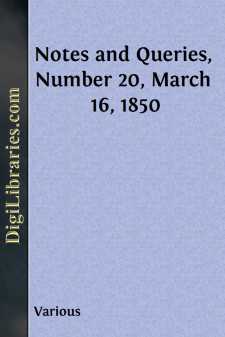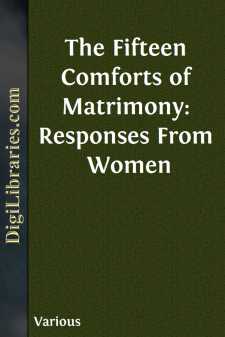Categories
- Antiques & Collectibles 13
- Architecture 36
- Art 48
- Bibles 22
- Biography & Autobiography 813
- Body, Mind & Spirit 142
- Business & Economics 28
- Children's Books 17
- Children's Fiction 14
- Computers 4
- Cooking 94
- Crafts & Hobbies 4
- Drama 346
- Education 46
- Family & Relationships 57
- Fiction 11829
- Games 19
- Gardening 17
- Health & Fitness 34
- History 1377
- House & Home 1
- Humor 147
- Juvenile Fiction 1873
- Juvenile Nonfiction 202
- Language Arts & Disciplines 88
- Law 16
- Literary Collections 686
- Literary Criticism 179
- Mathematics 13
- Medical 41
- Music 40
- Nature 179
- Non-Classifiable 1768
- Performing Arts 7
- Periodicals 1453
- Philosophy 64
- Photography 2
- Poetry 896
- Political Science 203
- Psychology 42
- Reference 154
- Religion 513
- Science 126
- Self-Help 84
- Social Science 81
- Sports & Recreation 34
- Study Aids 3
- Technology & Engineering 59
- Transportation 23
- Travel 463
- True Crime 29
Notes and Queries, Number 20, March 16, 1850
by: Various
Categories:
Description:
Excerpt
NOTES.
KING ALFRED'S GEOGRAPHY OF EUROPE.
There is no other printed copy of the A.-S. Orosius than the very imperfect edition of Daines Barrington, which is perhaps the most striking example of incompetent editorship which could be adduced. The text was printed from a transcript of a transcript, without much pains bestowed on collation, as he tells us himself. How much it is to be lamented that the materials for a more complete edition are diminished by the disappearance of the Lauderdale MS., which, I believe, when Mr. Kemble wished to consult it, could not be found in the Library at Ham.
Perhaps no more important illustration of the Geography of the Middle Ages exists than Alfred's very interesting description of the Geography of Europe, and the Voyages of Othere and Wulfstan; and this portion of the Hormesta has received considerable attention from continental scholars, of which it appears Mr. Hampson is not aware. As long since as 1815 Erasmus Rask (to whom, after Jacob Grimm, Anglo-Saxon students are most deeply indebted) published in the Journal of the Scandinavian Literary Society (ii. 106. sq.) the Anglo-Saxon Text, with a Danish translation, introduction, and notes, in which many of the errors of Barrington and Forster are pointed out and corrected. This was reprinted by Rask's son in the Collection he gave of his father's Dissertation, in 2 vols. Copenhagen, 1834.
Mr. Thorpe, in the 2nd edit. of his Analecta, has given "Alfred's Geography," &c., no doubt accurately printed from the Cotton MS., and has rightly explained Apdrede and Wylte in his Glossary, but does not mention Æfeldan; and Dr. Leo, in his Sprachproben, has given a small portion from Rask, with a few geographical notes. Dr. Ingram says: "I hope on some future occasion to publish the whole of 'Alfred's Geography,' accompanied with accurate maps."
Rask has anticipated Mr. Hampson's correction respecting the Wilti, and thus translates the passage: "men norden for Oldsakserne er Obotriternes Land, og i Nordost Vilterne, som man kalder Æfelder." The mistake of Barrington and Dr. Ingram is the more extraordinary when it is recollected that no people are so frequently mentioned in the chronicles of the Middle Ages as this Sclavonic tribe: citations might be given out of number, in which their contests with their neighbours the Obotriti, Abodriti, or Apdrede of Alfred are noticed. Why the Wilti were sometimes called Æfeldi or Heveldi, will appear from their location, as pointed out by Ubbo Emmius: "Wilsos, Henetorum gentem, ad Havelam trans Albim sedes habentem." (Rer. Fris. Hist. l. iv. p. 67.) Schaffarik remarks, "Die Stoderaner und Havelaner waren ein und derselbe, nur durch zwei namen interscheiden zweige des Weleten stammes;" and Albinus says: "Es sein aber die riehten Wilzen Wender sonderlich an der Havel wonhaft." They were frequently designated by the name of Lutici, as appears from Adam of Bremen, Helmond, and others, and the Sclavonic word liuti signified wild, fierce, &c. Being a wild and contentious people, not easily brought under the gentle yoke of Christianity, they figure in some of the old Russian sagas, much as the Jutes do in those of Scandinavia; and it is remarkable that the names of both should have signified giants or monsters....












